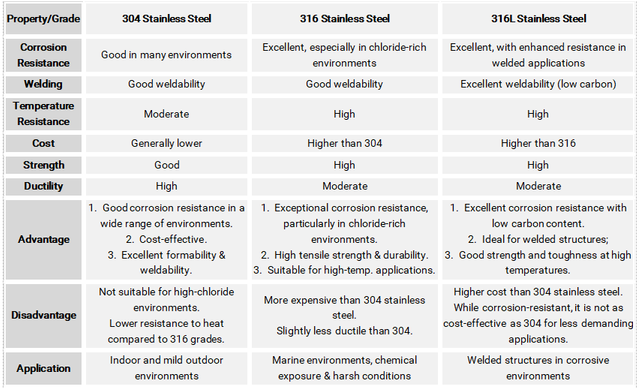Stainless Steel 304, 316 VS 316L
Stainless steel is a versatile material widely used across various industries because of its durability, corrosion resistance, and aesthetic appeal. Among the numerous grades available, 304, 316, and 316L are some of the most commonly used. Below, we’ll explore their differences.
304 Stainless Steel
304 stainless steel is an austenitic grade composed of approximately 18% chromium and 8%–10.5% nickel. This composition provides excellent corrosion resistance and good formability.
Renowned for its high tensile strength and oxidation resistance, 304 is suitable for a broad range of applications. However, it is less effective in chloride-rich environments compared to 316 grades.
316 Stainless Steel
316 stainless steel contains 16%–18% chromium, 10%–14% nickel, and 2%–3% molybdenum. The addition of molybdenum enhances its resistance to pitting and corrosion, particularly in chloride-exposed settings.
Often referred to as marine-grade stainless steel, 316 is ideal for harsh environments due to its superior corrosion resistance. It also boasts excellent welding and fabrication properties.
316L Stainless Steel
316L is a low-carbon version of 316 stainless steel. It has a similar composition but with a maximum carbon content of 0.03%.
The reduced carbon content minimizes the risk of carbide precipitation during welding, making 316L an excellent choice for welded applications. It maintains the same corrosion resistance as 316 but performs better in high-temperature environments.
Applications
304 Stainless Steel:
Food and Beverage Industry: Used in food processing equipment, kitchen appliances, and storage containers.
Architectural Applications: Employed in building facades, railings, and decorative elements.
Chemical Industry: Suitable for containers and pipelines with minimal chloride exposure.
316 Stainless Steel:
Marine Industry: Commonly used in shipbuilding, boat fittings, and offshore platforms.
Pharmaceutical and Medical Equipment: Ideal for applications requiring high hygiene standards.
Oil and Gas Industry: Used in equipment and piping systems operating in harsh environments.
316L Stainless Steel:
Welded Applications: Ideal for pressure vessels, storage tanks, and other welded structures.
Food and Beverage Industry: Used in sanitary equipment and food processing systems.
Chemical Processing: Suitable for reactors and storage tanks handling corrosive substances.
314, 316 and 316L are also the common housing and sensor material for sensors, flow meters and other measuring instrument. When deciding these materials, we can select basically from the below info:
How to Select Between 314, 316 and 316L for Sensors and Flowmeters?